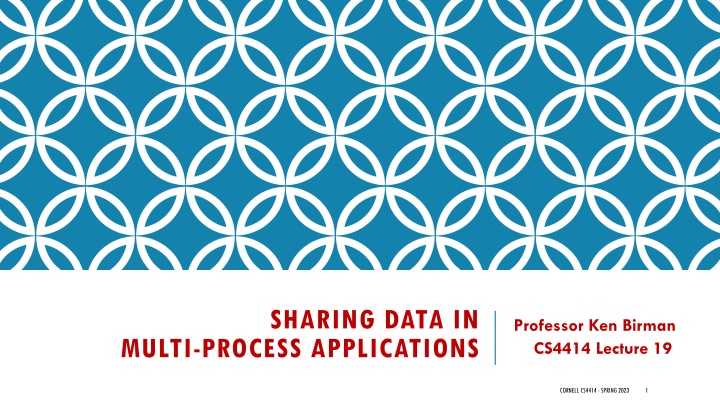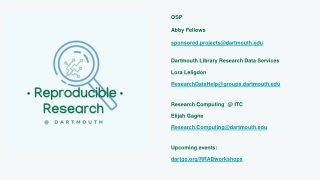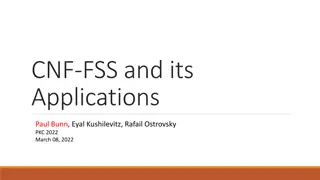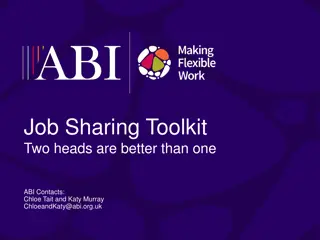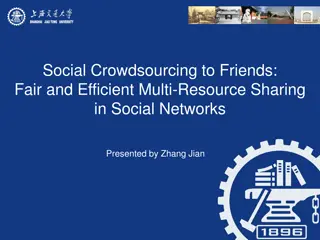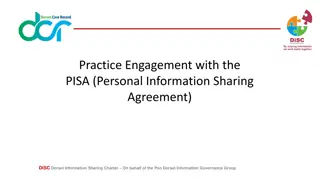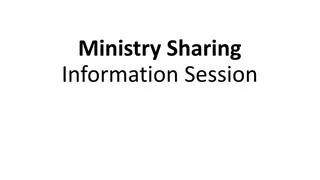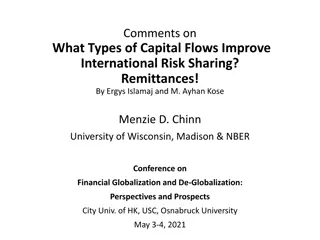Sharing Data in Multi-Process Applications
Modern solutions for running applications on clusters or in the cloud require effective data sharing approaches that work across local and remote processes. Large, complex systems often involve multiple processes needing to share data, which can be in different languages like Java, Python, and C++. This lecture delves into the challenges and strategies for sharing data in modern systems, as well as the distinction between local and remote process interactions.
Download Presentation

Please find below an Image/Link to download the presentation.
The content on the website is provided AS IS for your information and personal use only. It may not be sold, licensed, or shared on other websites without obtaining consent from the author.If you encounter any issues during the download, it is possible that the publisher has removed the file from their server.
You are allowed to download the files provided on this website for personal or commercial use, subject to the condition that they are used lawfully. All files are the property of their respective owners.
The content on the website is provided AS IS for your information and personal use only. It may not be sold, licensed, or shared on other websites without obtaining consent from the author.
E N D
Presentation Transcript
SHARING DATA IN Professor Ken Birman CS4414 Lecture 19 MULTI-PROCESS APPLICATIONS CORNELL CS4414 - SPRING 2023 1
IDEA MAP FOR TODAY Modern solutions of this kind often need to run on clusters of computers or in the cloud, and need sharing approaches that work whether processes are local (same machine) or remote. Complex Systems often have many processes in them. They are not always running on just one computer. Linux offers too many choices! They include pipes, mapped files (shared memory), DLLs. Linux weakness: the single machine look and feel. As a developer, you think of the cloud itself as a kind of distributed operating system kernel, offering tools that work from anywhere . CORNELL CS4414 - SPRING 2023 2
LARGE, COMPLEX SYSTEMS Large systems often involve multiple processes that need to share data for various reasons. Components may be in different languages: Java, Python, C++, O CaML, etc Big applications are also broken into pieces for software engineering reasons, for example if different teams collaborate CORNELL CS4414 - SPRING 2023 3
MODERN SYSTEMS DISTINGUISH TWO CASES Many modern systems use standard libraries to interface to storage systems, or for other system services. You think of the program as an independent agent, but it uses the same library as other programs in the application. Here, the focus is on how to build libraries that many languages can access. C++ is a popular choice. CORNELL CS4414 - SPRING 2023 4
LOCAL OPTIONS These assume that the two (or more) programs live on the same machine. They might be coded in different languages, which also can mean that data could be represented in memory in different ways (especially for complicated objects or structures but even an integer might have different representations!) CORNELL CS4414 - SPRING 2023 5
SINGLE ADDRESS SPACE, TWO (OR MORE) LANGUAGES Issue: They may not use the same data representations! CORNELL CS4414 - SPRING 2023 6
EXAMPLE 1: JAVA NATIVE INTERFACE The Java Native Interface (JNI) allows Java applications to talk to libraries in languages like C or C++. In effect, you build a Java wrapper for each library method. JNI will load the C++ DLL at runtime and verify that it has the methods you expected to find. CORNELL CS4414 - SPRING 2023 7
JNI DATA TYPE CONVERSIONS JNI has special accessor methods to access data in C++, and then the wrapper can create Java objects that match. For some basic data types, like int or float, no conversion is needed. For complex ones, where conversion does occur, the cost is similar to the cost of copying. JNI is generally viewed as a high-performance option CORNELL CS4414 - SPRING 2023 8
EXAMPLE 2: FORTRAN TO C++ Fortran is a very old language, and the early versions made memory structs visible and very easy to access. This is still true of modern Fortran: the language has evolved enormously, but it remains easy to talk to native data types. So Fortran to C++ is particularly effective. CORNELL CS4414 - SPRING 2023 9
EXAMPLE 3: PYTHON TO C++ (TRICKY) There are many Python implementations. The most widely popular ones are coded in C and can easily interface to C++. There are also versions coded in Java, etc. But because Python is an interpreter, Python applications can t just call into C++ without a form of runtime reflection. CORNELL CS4414 - SPRING 2023 10
HOW PYTHON FINESSES THIS Python is often used control computations in external systems. For example, we could write Python code to tell a C++ library to load a tensor, multiply it by some matrix, invert the result, then compute the eigenvalues of the inverted matrix The data could live entirely in C++, and never actually be moved into the Python address space at all! Or it could even live in a GPU CORNELL CS4414 - SPRING 2023 11
PYTHON INTEGERS One example of why it isn t so trivial to just share data is that Python has its own way of representing strings and even integers A Python integer will use native representations and arithmetic if the integer is small. But Python automatically switches to a larger number of bits as needed and even to a Bignum version. So if Python wants to send an integer to C++, we run into the risk that a C++ integer just can t hold the value! CORNELL CS4414 - SPRING 2023 12
SOLUTION? USE BINDINGS Boost.Python leverages this basic mechanism to let you call Python from C++ or C++ from Python. 1) You need to create a plain C (not C++) interface layer. These methods can only take native data types + pointers. 2) Compile it and create a DLL. In Python, load this DLL, then import the interface methods. 4) Now you can call those plain C methods, if you follow certain (well-documented) rules (like: no huge integers!). To call an object instance method, you pass a pointer to the object and then the arguments, as if this was a hidden extra argument. CORNELL CS4414 - SPRING 2023 13
EXAMPLE 4: MICROSOFT DOTNET CLR Microsoft has many supported languages, including C++ on Ubuntu (just install WSL2 on your laptop) But C# (a variant of Java) is probably the most popular. It turns out that ALL of them can talk to C++ via something called the dotnet common language runtime (dotnet CLR). CORNELL CS4414 - SPRING 2023 14
ISSUE IS SIMILAR TO PYTHON, JAVA As with those languages, you do need to decide if the memory for objects will be hosted in dotnet or hosted in C++ For objects hosted in dotnet there are methods you call to prevent garbage collection or compaction while your C++ is active. For objects hosted in C++, the dotnet languages can use unsafe memory pointers to access them CORNELL CS4414 - SPRING 2023 15
SHARING WITH DIFFERENT PROCESSES Issue: They have different address spaces! CORNELL CS4414 - SPRING 2023 16
SHARING BETWEEN DIFFERENT PROCESSES Large multi-component systems that explicitly share objects from process to process need tools to help them do this. Unlike language-to-language, the processes won t be linked together into a single address space. Because cloud computing is so popular, these tools often are designed to work over a network, not just on a single NUMA computer. CORNELL CS4414 - SPRING 2023 17
IF PROCESSES ARE ON A SINGLE (NUMA) MACHINE, WE HAVE A FEW OLD SHARING OPTIONS: 1. Single address space, threads share memory directly. 2. Linux pipes. Assumes a one-way structure. 3. Shared files. Some programs could write data into files; others could later read those files. 4. Mapped files. Same idea, but now the readers can instantly see the data written by the (single) writer. Also useful as a way to skip past the POSIX API, which requires copying (from the disk to the kernel, then from the kernel into the user s buffer). CORNELL CS4414 - SPRING 2023 18
DIMENSIONS TO CONSIDER Performance, simplicity, security. Some methods have very different characteristics than others. Ease of later porting the application to a different platform. Some modern systems are built as a collection of processes on one machine, but over time migrate to a cluster of computers. Standardization. Whatever we pick, it should be widely used. CORNELL CS4414 - SPRING 2023 19
LETS LOOK AT SOME EXAMPLES The C++ command runs a series of sub-programs: 1. The C preprocessor , to deal with #define, #if, #include 2. The template analysis and expansion stage 3. The compiler, which has a parsing stage, a compilation stage, and an optimization stage. 4. The assembler 5. The linker they share data by creating files, which the next stage can read CORNELL CS4414 - SPRING 2023 20
WHY DOES C++ USE FILE SHARING? C++ was created as a multi-process solution for a single computer. In the old days we didn t have an mmap system call. Also, since one process writes a file, and the next one reads it sequentially and soon , after which it gets deleted, Linux is smart enough to keep the whole file in cache and might never even put it on disk. There are many such examples on Linux. Most, like C++, have a controlling process that launches subprocesses, and most share files from stage to stage. CORNELL CS4414 - SPRING 2023 21
MMAP OPTION We learned about mmap when we first saw the POSIX file system API. At one time people felt that mmap could become the basis for shared objects in Linux. Linux allocates a segment of memory for the mapped file. Mmap returns the base address of this segment. Idea: mmap a memory segment, then allocate objects in it. CORNELL CS4414 - SPRING 2023 22
A MAPPED FILE IS LIKE A BIG BYTE ARRAY This is sometimes very convenient. Only permits a single writer If the data being shared is some form of raw information, like pixels in a video display, or numbers in a matrix, it works well. There is a way to create a mapped file with no actual disk storage. This form of shared memory can be useful! CORNELL CS4414 - SPRING 2023 23
MAPPED FILES Many Wall Street trading firms have real-time ticker feeds of prices for the stocks and bonds and derivatives they trade. Often this is managed via a daemon that writes into a shared file. The file holds the history of prices. By mapping the head of the file, processes can track updates. A library accesses the actual data and handles memory fencing. CORNELL CS4414 - SPRING 2023 24
SHARED MEMORY: SHMEM Many gaming platforms use a set of processes that share memory directly, without pretending the data is in files. The shrmem system calls avoid all storage , so no I/O occurs. They end up with a pure mapped segment The advantage is that the game engine can be a separate process from the GUI. CORNELL CS4414 - SPRING 2023 25
SHARED MEMORY VIA SHMEM, SHMAT We also use shared memory to access video displays. The hardware for modern screens is quite fancy. But basically, there is a mapped memory segment your application can access. It sends commands as a stream to a special CPU running a special video language. It may also leverage a GPU. However, and this is important, there is no corresponding file on disk! The benefit of shared memory is that data rates are too high to write this data into a file or send it over a pipe. CORNELL CS4414 - SPRING 2023 26
SHARED MEMORY VIA SHMEM, SHMAT More powerful than mmap: supports two-way sharing But can be risky: if you don t trust your peer, they could corrupt the shared memory and cause your application to crash Popular for extreme performance CORNELL CS4414 - SPRING 2023 27
LINUX ITSELF USES MAPPED FILES The DLL concept ( linking ) is based on a mapped file. In that case the benefits are these: The file actually contains executable instructions. These must be in memory for the CPU to decode and execute. But the DLL can be shared between multiple applications, saving memory and improving L3 caching performance. CORNELL CS4414 - SPRING 2023 28
SHARING WITH PROCESSES ON DIFFERENT MACHINES Issue: Now we need to also deal with the network CORNELL CS4414 - SPRING 2023 29
NETWORKED SETTINGS REQUIRE DIFFERENT APPROACHES When we run in a networked environment, we need tools that will work seamlessly even if the processes are on different machines. Mapped files or segments are single-machine solutions. Mmap can be made to work over a network, but performance is disappointing and this option is not common. CORNELL CS4414 - SPRING 2023 30
CLOUD COMPUTING In other courses, you ll use modern cloud computing systems. Those are like a large multicomputer kernel, with services that programs can use no matter which machine they run on. Cloud computing has begun to reshape the ways we develop complex programs even on a single Linux machine. CORNELL CS4414 - SPRING 2023 31
DIFFERENT MACHINES + INTERNET 1. We will learn about TCP soon like a pipe, but between machines. This extends the pipe option to the cloud case! 2. We could use a technique called remote procedure call where one process can invoke a method in a remote on. We will learn about this soon, too. 3. We could pretend that everything is a web service, and use the same tools that web browsers are built from. CORNELL CS4414 - SPRING 2023 32
AMAZON.COM Prior to 2005, Amazon web pages were created by a single server per page. But these servers were just not fast enough. Famous study: 100ms delay reduces profits by nearly 10% Today, a request is handled by a first tier server supported by a collection of services (as many as 100 per page) CORNELL CS4414 - SPRING 2023 33
AMAZON INVENTED CLOUD COMPUTING! The Amazon services are used by browsers from all over the world: a networked model. And Amazon s explicit goal was to leverage warehouses full of computers (modern cloud computing data centers). So Amazon is a great example of a solution that needs to use networking techniques. CORNELL CS4414 - SPRING 2023 34
INSIDE THE CLOUD? Users of cloud computing platforms like Amazon s AWS, Microsoft s Azure, or Google Cloud don t need to see the internals. They see a file system that is available everywhere, as well as other kernel services that look the same from every machine. The individual machine runs Linux, yet these services make it very easy to spread one application over multiple machines! CORNELL CS4414 - SPRING 2023 35
AIR TRAFFIC CONTROL Ken worked on the French ATC solution This system has been continuously used since 1996. It runs on a private cloud, but uses cloud-computing ideas. ATC systems have many modules that cooperate. The flight plan is the most important form of shared information. CORNELL CS4414 - SPRING 2023 36
AIR TRAFFIC CONTROL SYSTEM Flight plan manager tracks current and past flight plan versions. Replicated for ultra-high reliability. Message bus . . . Microservices for various tasks, such as checking future plane separations, scheduling landing times, predicting weather issues, offering services to the airlines Flight plan update broadcast service Air traffic controllers update flight plans WAN link to other ATC centers CORNELL CS4414 - SPRING 2023 37
SOFTWARE ENGINEERING AT LARGE SCALE Big modern applications are created by software teams They define modular components, which could co-exist in one address space or might be implemented by distinct programs There is a science of software engineering that focuses on best ways of collaborating on big tasks of this kind. CORNELL CS4414 - SPRING 2023 38
SOFTWARE ENGINEERING AT LARGE SCALE Each team needs a way to work independently and concurrently. The teams agree on specifications for each component, then build, debug and unit test their component solutions. We often pre-agree on some of the unit tests: release validation tests and acceptance tests. Integration occurs later when all the elements seem to be working. CORNELL CS4414 - SPRING 2023 39
SHOULD WE SHARE OBJECTS OR FILES? If we agree that component A will do something, then produce a file that becomes input to component B, and we agree on the file format and contents, the teams can already start work. The A and B interfacing team would jointly construct some hand-crafted instances of the files A might output. Both teams check their solutions against these files. CORNELL CS4414 - SPRING 2023 40
FILES WORK IN ALL SETTINGS Up to now we have always used the local file system on our Linux machines. But Linux can also access a remote file system, and these can be shared by many machines. So sharing via files works at any scale. CORNELL CS4414 - SPRING 2023 41
ADVANTAGES OF FILES The B component team can run their solution again and again with the identical inputs. This facilitates debugging and is a valuable form of unit test. If the test files are complete, most of the B functionality gets checked. CORNELL CS4414 - SPRING 2023 42
DISADVANTAGES OF FILES Files need to be read block by block. Perhaps A works with objects and B is expected to treat them as objects. Yet the file will only contain bytes: the object format and layout is lost. The file blocks might not correspond to any form of data chunks CORNELL CS4414 - SPRING 2023 43
MORE DISADVANTAGES In Linux, temporary files are very common and can be inefficient: Editors write the whole new version of your file to disk, sync the file (to be sure it is actually on the disk), then use a file rename operation to atomically replace the old version. C++ stages use files to pass intermediary information Many applications have lock files, used very briefly. Issue: The file lifetime might be just a few milliseconds! CORNELL CS4414 - SPRING 2023 44
MORE DISADVANTAGES In Linux, temporary files are very common and can be inefficient: Editors write the whole new version of your file to disk, sync the file (to be sure it is actually on the disk), then use a file rename operation to atomically replace the old version. C++ stages use files to pass intermediary information Many applications have lock files, used very briefly. But some applications like databases and the editor actually need to be sure the temporary file was written to disk this is called write-ahead logging or write- ahead file storage and provides crash-tolerance guarantees. Those can t avoid the overheads of the disk I/O This issue was noticed by researchers about 15 years ago. Linux was modified to not actually write the data out, if permitted, and also to cache entire recently-written files in the kernel disk buffer, just in case it will be read immediately after creation. Issue: The file lifetime might be just a few milliseconds! CORNELL CS4414 - SPRING 2023 45
MULTI-LINGUAL ISSUE Modularity permis us to use different languages for different tasks. For example, a great deal of existing ATC code is in Fortran 77. Byte arrays (or text files, character strings) are a least common denominator. Every language has a way to easily access them. Modern systems have converged around the idea that this matches best with some form of message passing . CORNELL CS4414 - SPRING 2023 46
SERIALIZATION/DESERIALIZATION Converting an object to a byte array serializes the object. Later we deserialize to recreate the object. A serialized object can be stored in a file, or we can use a message passing technology to send them from process to process over a network. CORNELL CS4414 - SPRING 2023 47
FEATURES OF SERIALIZATION TECHNOLOGIES Some have notions of software version numbers. These allow you to ensure that software is properly patched and upgraded. It is unwise to pass an object from version 2.0 of some component to version 1.0 of the next component. This mix might never have been tested! CORNELL CS4414 - SPRING 2023 48
FULLY ANNOTATED OBJECTS? In addition to version numbering, it is important to document the data types in use, sizes of arrays, requirements or assumptions that methods are making, limits on sizes of things, permissions required, etc. It is easy to serialize an object into a byte-array format containing pure data. But there is very little agreement on how these annotation should look. CORNELL CS4414 - SPRING 2023 49
DATA REPRESENTATIONS AND PADDING An additional issue is that computers and languages can use different representations. For example, even on a single machine, some languages end character strings with a null byte (0). Others track the string length. And if data is shared between machines, different computer vendors often use CPU chips that represent numbers in different ways! CORNELL CS4414 - SPRING 2023 50
